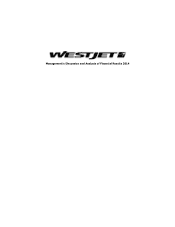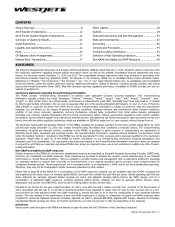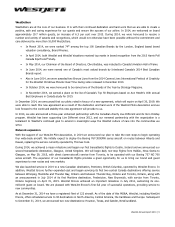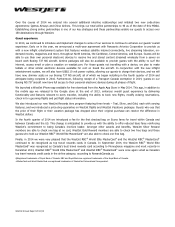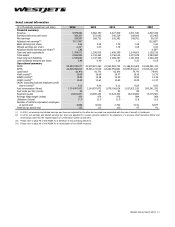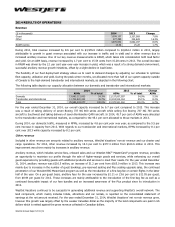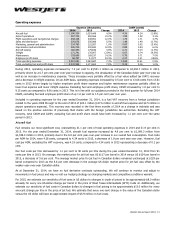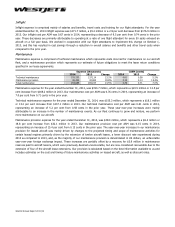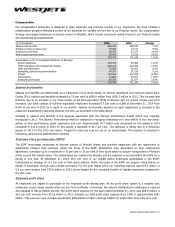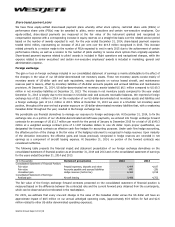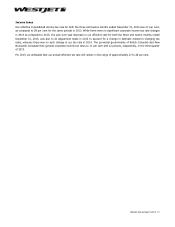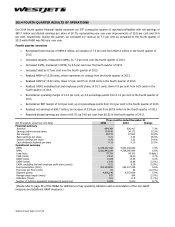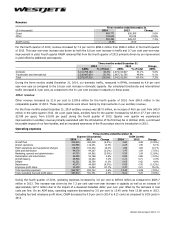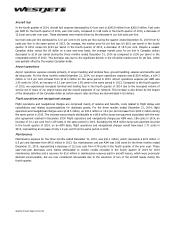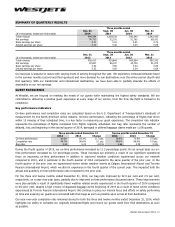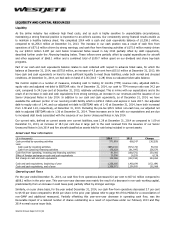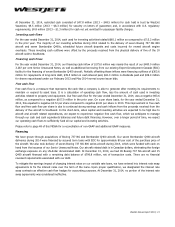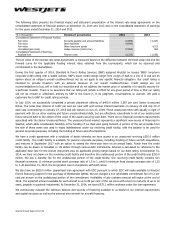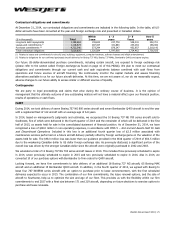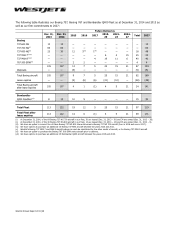Westjet 2014 Annual Report Download - page 18
Download and view the complete annual report
Please find page 18 of the 2014 Westjet annual report below. You can navigate through the pages in the report by either clicking on the pages listed below, or by using the keyword search tool below to find specific information within the annual report.
WestJet Annual Report 2014│16
Share-based payment plans
We have three equity-settled share-based payment plans whereby either stock options, restricted share units (RSUs) or
performance share units (PSUs) may be awarded to pilots, senior executives and certain non-executive employees. Our
equity-settled, share-based payments are measured at the fair value of the instrument granted and recognized as
compensation expense with a corresponding increase in equity reserves on a straight-line basis over the related service period
based on the number of awards expected to vest. For the year ended December 31, 2014, share-based payment expense
totaled $18.6 million, representing an increase of 28.2 per cent over the $14.5 million recognized in 2013. This increase
related primarily to a revision made to the number of PSUs expected to vest in early 2015 due to the achievement of certain
performance criteria, as well as a revision to the number of pilots electing to receive stock options than originally expected.
Share-based payment expense related to pilots’ awards is included in flight operations and navigational charges, while the
expense related to senior executives’ and certain non-executive employees’ awards is included in marketing, general and
administration expense.
Foreign exchange
The gain or loss on foreign exchange included in our consolidated statement of earnings is mainly attributable to the effect of
the changes in the value of our US-dollar-denominated net monetary assets. These net monetary assets consist mainly of
monetary assets of US-dollar cash and cash equivalents, security deposits on various leased aircraft, and maintenance
reserves paid to lessors, offset by monetary liabilities of US-dollar accounts payable and accrued liabilities and maintenance
provisions. At December 31, 2014, US-dollar-denominated net monetary assets totaled US $6.1 million compared to US $0.3
million in net monetary liabilities at December 31, 2013. The increase in net monetary assets compared to the year ended
December 31, 2013 is largely due to the increase in US-dollar cash and accounts receivable balances. We reported a foreign
exchange loss of $2.1 million in 2014 on the revaluation of our US-dollar denominated net monetary assets and liabilities and
a foreign exchange gain of $1.1 million in 2013. While at December 31, 2014 we were in a US-dollar net monetary asset
position, throughout the year we had a greater exposure on US-dollar-denominated monetary liabilities that, with a weakening
Canadian dollar throughout the year, resulted in the foreign exchange loss.
We periodically use financial derivatives to manage our exposure to foreign exchange risk. At December 31, 2014, to fix the
exchange rate on a portion of our US-dollar-denominated aircraft lease payments, we entered into foreign exchange forward
contracts for an average of US $11.7 million per month for the period of January to December 2015 for a total of US $140.3
million at a weighted average contract price of 1.1187 Canadian dollars to one US dollar. Upon proper qualification, we
designated the forward contracts as effective cash flow hedges for accounting purposes. Under cash flow hedge accounting,
the effective portion of the change in the fair value of the hedging instrument is recognized in hedge reserves. Upon maturity
of the derivative instrument, the effective gains and losses previously recognized in hedge reserves are recorded in net
earnings as a component of aircraft leasing expense. At December 31, 2014, no portion of the forward contracts was
considered ineffective.
The following table presents the financial impact and statement presentation of our foreign exchange derivatives on the
consolidated statement of financial position as at December 31, 2014 and 2013 and on the consolidated statement of earnings
for the years ended December 31, 2014 and 2013.
($ in thousands)
Statement presentation
2014
2013
Consolidated Statement of Financial Position:
Fair value Prepaid expenses, deposits and other 6,409 4,187
Fair value
Accounts payable and accrued liabilities
(49)
(29)
Unrealized gain Hedge reserves (before tax) 6,360 4,158
Consolidated Statement of Earnings:
Realized gain
Aircraft leasing
9,498
4,752
The fair value of the foreign exchange forward contracts presented on the consolidated statement of financial position is
measured based on the difference between the contracted rate and the current forward price obtained from the counterparty,
which can be observed and corroborated in the marketplace.
For 2015, we estimate that every one-cent change in the value of the Canadian dollar versus the US dollar will have an
approximate impact of $8.5 million on our annual unhedged operating costs, (approximately $5.9 million for fuel and $2.6
million related to other US-dollar denominated operating expenses).


